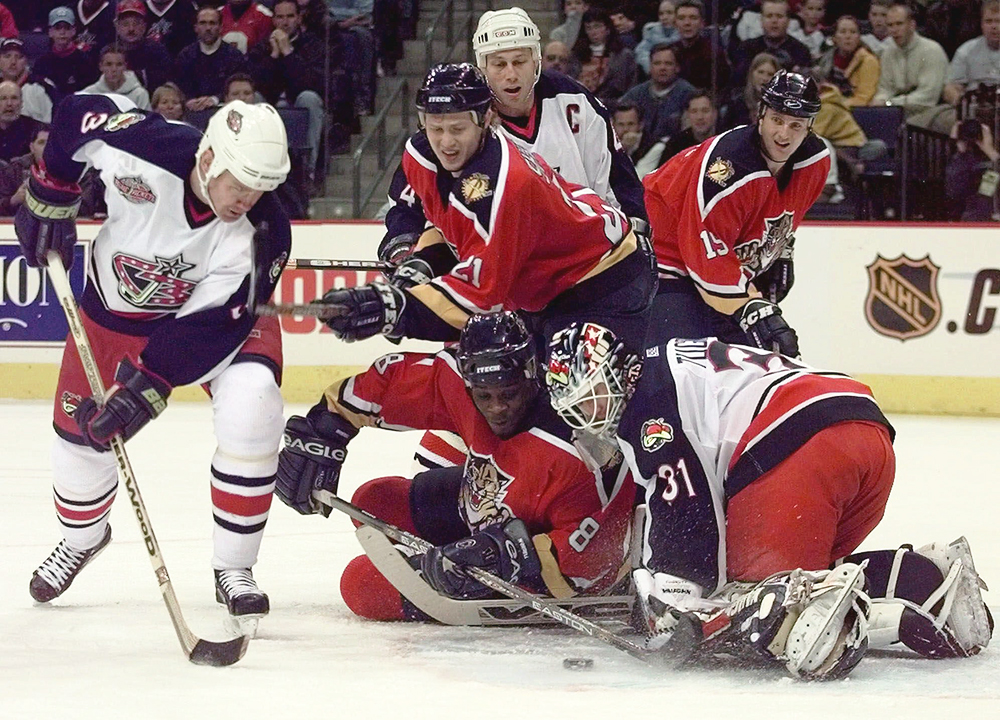In the five-part series, “What to Expect When You’re Expanding,” executives who helmed year one NHL expansion franchises in Atlanta, Anaheim, Nashville, Minnesota and Columbus share their stories from those early seasons—in part to show Vegas Golden Knights GM George McPhee just how good he and his team have it.
If you missed them, find part one—on Cliff Fletcher’s Atlanta Flames—here, part two—on the Sharks and Ducks—here, part three—on David Poile and the Predators—here, and part four—on the Minnesota Wild—here.
Erin Ginnell got his break into the NHL scouting ranks when he landed a job with the Columbus Blue Jackets in the run-up to their inaugural season. Now, the better part of 17 years later, he’s back with another startup, the Vegas Golden Knights, and while the task in front of the staff this June will be in some ways similar to that once faced by the Columbus management team, Ginnell says that the hockey landscape has changed mightily.
“It’s going to be a different pool of talent available this time,” Ginnell says. “It’s a different league. There are more players to choose from, more teams. And the fact is, every team back in 2000 carried a couple of big tough guys—they were the guys left unprotected because they were the players most easy to replace. Now you look at NHL teams’ lineups and there’s an emphasis on speed and smarts, even down on the third and fourth lines. Defencemen, even the fifth and sixth guys, have to be really mobile just because the game is so much faster now. There’s a lot more skill out there everywhere.”
Ginnell says Golden Knights GM George McPhee has adjusted accordingly. “There are going to be really good NHL players available but you just get one shot at it, so you have to get it right,” Ginnell says. “George has loaded up on [scouting] the pro side and it’s understandable why.”
In 2000 with the Blue Jackets, Ginnell focused on the amateur side, the entry draft, but the entire staff was brought in to consult on players who landed on management’s radar. That again will be the case in Vegas’s run-up to the expansion and entry drafts. Ginnell will spend most of the season looking at the class of 1999 birthdays spread across the CHL, the USHL and Europe. But when McPhee makes up the mock-protected lists and targets NHL or minor-pro players, everyone will chip in.
“Our staff has people who have worked in a lot of different organizations,” Ginnell says. “It might be someone who came through the Washington or Islanders organizations when George was with those teams. It might be someone who [Vegas special advisor] David Conte knew from his time in New Jersey. It might be someone who [Vegas AGM] Kelly McCrimmon knew when he was coaching in the Dub [WHL]. When it gets to the time to make the lists, everyone is involved to some extent.”

Prior to signing on with the Golden Knights, Ginnell worked for the Florida Panthers for more than 10 years. For the last five he headed the Panthers’ amateur scouting department, reporting to Scott Luce, who was then Florida’s director of scouting. Both were let go by the Panthers this summer and both signed on with Vegas in late August, Luce as the head of amateur scouting and Calgary-based Ginnell as the lead man in the Western region.
“We’ve had a great working relationship for a lot of years now, so there’s some comfort level coming in with Scott,” Ginnell says. “Other people I’ve met before but probably not talked to a lot. That’s basically how it was in Columbus. Doug MacLean [Columbus’s original GM] had a relationship with Don Boyd [the No. 2 man with the Blue Jackets] going back to junior hockey, but really it wasn’t like a clique, a bunch of guys who moved from one organization to another.”
The Blue Jackets came into the league with the Minnesota Wild back in 2000. While then-Minnesota GM Doug Risebrough was on the lookout for players with possible upside who had been lost in the shuffle in their organizations, MacLean focused on established NHL players. “I think [MacLean] was looking to spend more money than we were,” Risebrough says.
The talent that the Blue Jackets came away with out of the expansion draft is pretty consistent with both Risebrough’s observation about Columbus’s financial resources and Ginnell’s description of the state of the league circa 2000. The well-known veterans on the Blue Jackets’ list had all seen better days. Kevin Dineen had scored 45 goals in a season, but that was back in ’89 and by the time he landed in Columbus, he was a 35-year-old role-playing third- and fourth-liner. Geoff Sanderson had scored 46 goals for Hartford seven years before but in 142 games over the two previous seasons he had scored a total of 25 goals. Lyle Odelein had won a Stanley Cup with Montreal back in ’93 but, at 32 and with a lot of wear and tear, he was playing the back nine of his career and could see the clubhouse.
MacLean took a couple of big swings: he drafted Mathieu Schneider, but Schneider declined to sign with the club and went to Los Angeles as a free agent.
MacLean wheeled and dealed: While Cliff Fletcher in Atlanta and other GMs of expansion teams traded veteran assets for futures, MacLean wasn’t averse to moving in the other direction. For instance, he drafted Turner Stevenson, the very definition of a bottom-of-the-roster tough guy, and moved him to New Jersey for Krzysztof Oliwa, who was himself soon traded to Pittsburgh for 32-year-old defenceman Frantisek Kucera. A player included in the Stevenson deal, Deron Quint, turned out to be the only Blue Jacket under the age of 25 to score more than 10 points in the inaugural season.

With Sanderson leading the way with 30 goals, the Blue Jackets wound up with 71 points in their debut campaign—three points ahead of Minnesota in the standings but at a significant long-run cost. In their second season, the Jackets fell to 57 points, second last in the league, while the Wild made baby steps up to 73 points. In Year Three, Columbus bounced back somewhat (to 69 points) but that spring the Wild made the Western Conference final. By the time the Blue Jackets made the playoffs in their eighth year of existence, there had been a turnover in the front office.
Ginnell observed that shift from a distance—he left Columbus after two seasons, spent a year with Colorado and then signed on with Florida.
“It’s easy to have hindsight about some of the decisions,” Ginnell says. “In that stretch there were a couple of draft choices that didn’t work out the way you’d have hoped. I think one of the reasons that we were able to turn things around in Florida last season was the fact that we made some deals and loaded up on draft picks. We wound up with 23 picks [total] in the 2010 and 2011 drafts—it was like getting three drafts in two years and that changes the dynamic of things, maybe not overnight but two or three seasons down the line.”
McPhee has sent out the message that he envisions drafting the top of his roster rather than landing big names in trade or on the free-agent market. And McPhee’s hiring of McCrimmon, the longtime GM and coach of the Brandon Wheat Kings, underscores his commitment to amateur scouting—music to the ears of Luce and Ginnell.
If Minnesota’s expansion draft takeaway proves that there are some buried treasures in organizations, then the lesson drawn from the Columbus draft is painfully plain: You might get some value with 30-year-olds in the expansion draft, but three years down the line their value is not quite equal to the price tag on their rookie cards.









